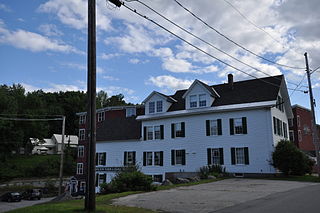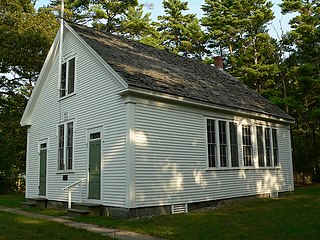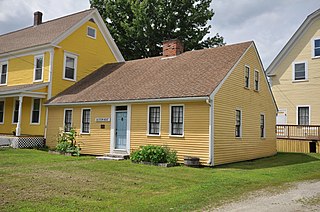
The Wales and Hamblen Building is a historic commercial building at 260 Main Street in Bridgton, Maine. Built in 1882, it is a fine example of late Italianate architecture, and one of the town's most architecturally sophisticated commercial buildings. It was listed on the National Register of Historic Places.

The Lord Block is a historic commercial building in downtown Lewiston, Maine. Built in 1865, it is one of downtown Lewiston's oldest commercial buildings, and a reminder of the city's early commercial character. The building was listed on the National Register of Historic Places in 1986.

The Elms is a historic building at the junction of Lewiston and Elm Streets in Mechanic Falls, Maine. Built as a hotel in 1859 and used for a variety of purposes since then, the substantial building is a fine late expression of Greek Revival architecture, and a reminder of the town's heyday as an industrial center. It was listed on the National Register of Historic Places in 1985.

The North Jay Grange Store is an historic Grange Hall and store on East Dixfield Road in the village of North Jay in Jay, Maine. It was built in 1895 by North Jay Grange No. 10 to replace its hall on the same site which had burned down earlier that year. Part of the building was later set aside for a Grange store. Closed in 1976, the Grange Store claimed to be the last of its type in the nation. On October 23, 1974, it was listed on the National Register of Historic Places in 1974.

The Abial Cushman Store is a historic commercial building at 2766 Lee Road in Lee, Maine. Built in 1840, it is one of the rural community's few surviving 19th-century commercial buildings, and one of its few examples of Greek Revival architecture.

The Bass Boarding House is an historic house on Canal Street in Wilton, Maine, United States. It was built in 1860s, and adapted for use as worker housing for G.H. Bass & Co., whose former factory building stands next door. The building, one of a few that survive in Wilton that were adapted in this way, was added to the National Register of Historic Places in 1988. It now houses the Wilton Historical Society's Wilton Farm and Home Museum.

The Hubbard–Cotton Store is a historic commercial building on the corner of River Rd and Mountain View Ave, near its junction with 113 in the center of Hiram, Maine. Built c. 1850, it is locally notable as one of the only non-residential historic structures in the small town, and was operated for about 100 years by the Cotton family. It was listed on the National Register of Historic Places in 1990.

The J. & O. Irish Store is a historic retail building, now used as a museum, on Maine State Route 140 in Hartford, Maine. Built in 1888 by Orlando Irish, it is virtually unaltered since that time, representing a time capsule of the period in rural Maine. The building was listed on the National Register of Historic Places in 1983.

The Observer Building is a historic commercial and residential building located at 128 Union Square in Dover-Foxcroft, Maine. Built in 1854, it is an architecturally unusual Greek Revival wood-frame "flatiron" triangular building with a variable-pitch gable roof. In addition to its architectural significance, it is also historically significant as the home for many years of The Piscataquis Observer, one of Maine's oldest weekly newspapers. The building is now owned by the Dover-Foxcroft Historical Society, which uses it as a museum and storage space.

The Division No. 9 School is a historic former one-room schoolhouse on Maine State Route 9 in Wells, Maine. Built in 1900, it is the best-preserved of the town's surviving district school buildings, and is now a museum owned by the town. It was listed on the National Register of Historic Places in 1995.

Elden's Store is a historic commercial building on Long Plains Road in the center of Buxton, Maine. Built in 1802, it is the oldest commercial building in the rural community, and is one of the few historic brick commercial buildings in western York County. The building, which is now owned by the local historical society, was listed on the National Register of Historic Places in 1983.

The Spaulding House is a historic house on Main Street in Norridgewock, Maine. Built about 1835 by one of the town's early settlers, it is a fine local example of Greek Revival executed in brick. The house was listed on the National Register of Historic Places in 1978.

The Seven Star Grange is a historic Grange hall at 696 Bangor Road in Troy, Maine. Built in 1876, it is one of the state's oldest Grange halls, and has been an important community and social event venue for the rural community since then. It was listed on the National Register of Historic Places in 2011.

The Blossom House is a historic house museum on Main Street in Monmouth, Maine. Built about 1808, it is a well-preserved example of a Federal period Cape style house. It was listed on the National Register of Historic Places in 1989, and now serves as a museum for the local historical society.

The Chandler Store is a historic formerly commercial building on Maine State Route 27 in the center of the Belgrade Lakes village of Belgrade, Maine. Built in 1838, it is one of only two known commercial buildings in the state to be built out of granite blocks. It is now a private residence. It was listed on the National Register of Historic Places in 1985.

The Colburn School is a historic schoolhouse on Arnold Road in Pittston, Maine. With an estimated construction date of 1815, this brick schoolhouse is the best-preserved of the town's 19th-century district schools, and served for a time as the town hall. Now a local historical society museum, it was listed on the National Register of Historic Places in 2001.

The Percy District School House is a former district school at the junction of Parker Head and Cox Head Roads in Phippsburg, Maine. Now adapted for use as a private residence, this 1830s school house is one of a small number of 19th-century district schools in the state to be built out of granite blocks. It was listed on the National Register of Historic Places in 1999.

The Sail Loft is a historic commercial building on Front Street in the Tenants Harbor village of St. George, Maine. Built in 1860, it is one of the only surviving buildings from the village's 19th-century heyday as a shipbuilding center. It was listed on the National Register of Historic Places in 1977.

The Vickery Building is a historic commercial building at 261 Water Street in downtown Augusta, Maine. Built 1895 to a design by John C. Spofford, it is one of the downtown's few granite commercial buildings, built for Peleg O. Vickery, a leading publisher and three-term mayor of the city. It was listed on the National Register of Historic Places in 1984.

The Vienna Town House is a historic government building on Maine State Route 41 in Vienna, Maine. Built in 1854-55, it is a well-preserved local example of transitional Greek Revival-Italianate architecture. It was listed on the National Register of Historic Places in 1982. It continues to be used for municipal functions.

















